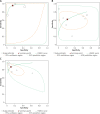Comparison of diagnostic accuracy of saline infusion sonohysterography, transvaginal sonography, and hysteroscopy in evaluating the endometrial polyps in women with abnormal uterine bleeding: a systematic review and meta-analysis
- PMID: 32904526
- PMCID: PMC7457193
- DOI: 10.5114/wiitm.2020.93791
Comparison of diagnostic accuracy of saline infusion sonohysterography, transvaginal sonography, and hysteroscopy in evaluating the endometrial polyps in women with abnormal uterine bleeding: a systematic review and meta-analysis
Abstract
Introduction: In women with abnormal uterine bleeding (AUB), endometrial polyps are a frequent finding, and the risk of a focal (pre)malignancy in a polyp is up to 6%. Because of this reported risk, the detection of polyps in these women is important.
Aim: To evaluate and compare the diagnostic accuracy of saline infusion sonohysterography, transvaginal sonography, and hysteroscopy in detecting endometrial polyps in women with AUB.
Material and methods: The searches were conducted by two independent researchers to find the relevant studies published from 1/1/2009 until the end of 30/06/2019. We searched for published literature in English language in MEDLINE, EMBASETM, The Cochrane Library, and Trip database. For literature published in other languages, we searched national databases (Magiran and SID), KoreaMed, and LILACS. The risk of bias of every article was evaluated by using QUADAS-2.
Results: After selection and quality assessment, 11 studies were included. Based on the random effect model the total prevalence of endometrial polyps in women with abnormal uterine bleeding was 38%. The sensitivity and specificity of saline infusion sonohysterography in diagnosis of endometrial polyps were 0.87 and 0.86, respectively. The sensitivity and specificity of transvaginal ultrasonography were 0.62 and 0.73 and the sensitivity and specificity of hysteroscopy were 0.92 and 0.85, respectively.
Conclusions: Although that sonohysterography is a safe and relatively cheap method, which allows ruling out or confirming endometrial polyps, it cannot be replaced with hysteroscopy due to the fact that hysteroscopy combined with biopsy is the gold standard for ruling out malignancies in an endometrial polyp.
Keywords: abnormal uterine bleeding; saline infusion sonohysterography; sonohysterography; transvaginal sonography.
Copyright: © 2020 Fundacja Videochirurgii.
Conflict of interest statement
The authors declare no conflict of interest.
Figures







Similar articles
-
Comparison of transvaginal sonography and saline contrast sonohysterography in women with abnormal uterine bleeding: correlation with hysteroscopy and histopathology.Int J Health Sci (Qassim). 2007 Jan;1(1):17-24. Int J Health Sci (Qassim). 2007. PMID: 21475448 Free PMC article.
-
Diagnostic accuracy of saline contrast sonohysterography in detecting endometrial polyps in women with postmenopausal bleeding: systematic review and meta-analysis.Ultrasound Obstet Gynecol. 2019 Jul;54(1):28-34. doi: 10.1002/uog.20229. Epub 2019 Jun 12. Ultrasound Obstet Gynecol. 2019. PMID: 30693579
-
Transvaginal sonography, saline contrast sonohysterography and hysteroscopy for the investigation of women with postmenopausal bleeding and endometrium > 5 mm.Ultrasound Obstet Gynecol. 2001 Aug;18(2):157-62. doi: 10.1046/j.1469-0705.2001.00472.x. Ultrasound Obstet Gynecol. 2001. PMID: 11529998
-
Usefulness of saline infusion sonohysterography and feeding artery imaging in endometrial polyp diagnosis.Ginekol Pol. 2017;88(6):285-288. doi: 10.5603/GP.a2017.0054. Ginekol Pol. 2017. PMID: 28727125
-
Two-dimensional transvaginal sonography vs saline contrast sonohysterography for diagnosing endometrial polyps: systematic review and meta-analysis.Ultrasound Obstet Gynecol. 2020 Oct;56(4):506-515. doi: 10.1002/uog.22161. Epub 2020 Sep 14. Ultrasound Obstet Gynecol. 2020. PMID: 32730635
Cited by
-
Recent Imaging Updates and Advances in Gynecologic Malignancies.Cancers (Basel). 2022 Nov 10;14(22):5528. doi: 10.3390/cancers14225528. Cancers (Basel). 2022. PMID: 36428624 Free PMC article. Review.
-
Evaluation of pain during diagnostic and surgical minihysteroscopy under local anesthesia.Arch Med Sci. 2023 Aug 17;21(2):463-470. doi: 10.5114/aoms/169979. eCollection 2025. Arch Med Sci. 2023. PMID: 40395882 Free PMC article.
-
Abnormal Uterine Bleeding in Perimenopausal Women: The Role of Hysteroscopy and Its Impact on Quality of Life and Sexuality.Diagnostics (Basel). 2022 May 9;12(5):1176. doi: 10.3390/diagnostics12051176. Diagnostics (Basel). 2022. PMID: 35626331 Free PMC article. Review.
-
The typical polypoid adenomyoma is a special form of endometrial polyp: a case-controlled study with a large sample size.Eur J Med Res. 2023 Aug 30;28(1):308. doi: 10.1186/s40001-023-01286-1. Eur J Med Res. 2023. PMID: 37649048 Free PMC article.
-
Abnormal uterine bleeding: The well-known and the hidden face.J Endometr Uterine Disord. 2024 Jun;6:100071. doi: 10.1016/j.jeud.2024.100071. Epub 2024 Apr 1. J Endometr Uterine Disord. 2024. PMID: 38764520 Free PMC article.
References
-
- Short J, Sharp B, Elliot N, et al. Does the addition of saline infusion sonohysterography to transvaginal ultrasonography prevent unnecessary hysteroscopy in premenopausal women with abnormal uterine bleeding? Aust N Zeal J Obstet Gynaecol. 2016;56:432–5. - PubMed
-
- Inoue T, Kitajima M, Taniguchi K, Masuzaki H. Three-dimensional saline-infusion sonohysterography is useful for the identification of endometrial polyp. J Obstet Gynaecol Res. 2016;42:855–9. - PubMed
-
- Bradley LD, Gueye NA. The medical management of abnormal uterine bleeding in reproductive-aged women. Am J Obstet Gynecol. 2016;214:31–44. - PubMed
-
- Shea AK. Comparison of saline infusion sonohysterography and transvaginal ultrasound in detection of endometrial polyps. EC Gynaecol. 2018;7:260–4.
LinkOut - more resources
Full Text Sources
Other Literature Sources
